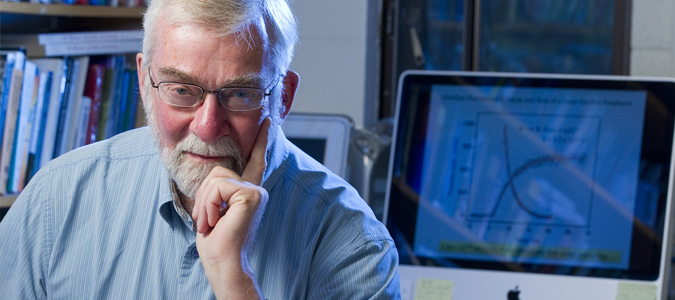Solar research at U of S gets $492,000 boost
Developing cheaper, tougher solar cells is the goal of University of Saskatchewan chemistry researcher Ron Steer, who today was awarded $492,000 from the federal Natural Sciences and Engineering Research Council (NSERC) under their Strategic Projects Grants program.
By Mark Ferguson "Solar energy represents the ultimate source of ‘green' power," Steer said. "The available global supply represents about 10,000 times the world's current combined electrical generation capacity."
"Solar energy represents the ultimate source of ‘green' power," Steer said. "The available global supply represents about 10,000 times the world's current combined electrical generation capacity."Harvesting this abundance is a challenge. The best solar cells, such as those used in spacecraft, are about 40 per cent efficient, while typical consumer-level photovoltaics deliver, at most, about 12 per cent. Both are still much too expensive for widespread use in solar energy farms. Organic (carbon-based) solar cells are considerably cheaper, but also much less efficient and too fragile for commercial use. It is here where Steer and his colleagues hope to make progress.
Steer and his team, which includes Ian Burgess, Tim Kelly, Matt Paige and Rob Scott, are working to improve organic photovoltaics – known as dye-sensitized solar cells (DSCs) – by letting them use more of the sunlight that hits them. In particular, they have discovered a way that could allow DSCs to use near-infrared light—those same rays that we feel as warmth on our skin on a summer's day. More than half of the sun's energy reaches the Earth's surface as infrared light.
"Developing clean energy and the technology to allow us to harvest it are some of the challenges being addressed in our signature areas of research," said Karen Chad, U of S vice-president research. "Outstanding work such as Dr. Steer's is key to our strength in this area."
The team is also working on the problem of durability. Organic photovoltaics are brittle and don't last long. By incorporating extremely tough materials such as carbon nanotubes, they hope to create solar cells that are cheap, durable, and deliver more energy.
Steer's leading-edge work in organic photovoltaics is the product of more than three decades of fundamental, curiosity-driven research. A physical chemist in molecular spectroscopy, he leads the Photovoltaic Research Group. He was named a U of S Distinguished Chair in 2011.
Steer's group is one of 70 scientific teams at universities across the country supported in this latest round of funding from NSERC, collectively representing an investment of more than $32 million over three years. Teams are working in a wide range of areas, including environment, information and communications technologies, manufacturing, and natural resources and energy.
"We received a large number of very high-quality submissions, and the peer review committees evaluating them were impressed with the excellence of the research teams, the importance and potential impact of the proposed research, and the strong support from partners," said NSERC President Suzanne Fortier.
For more information on research at the U of S, visit the
Research Communications website

